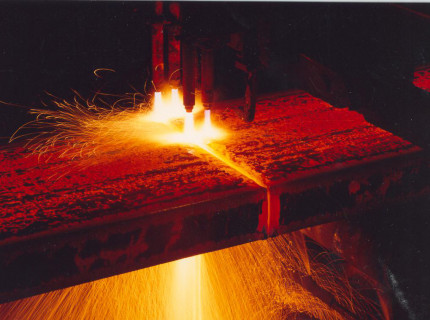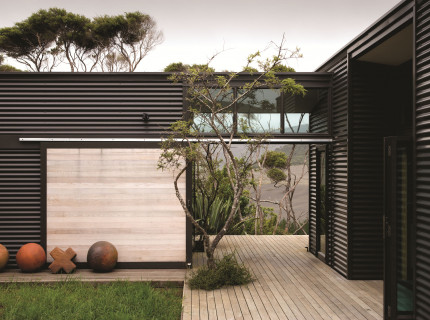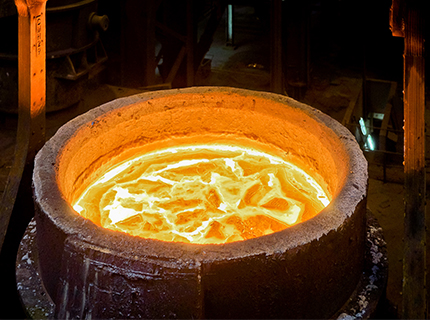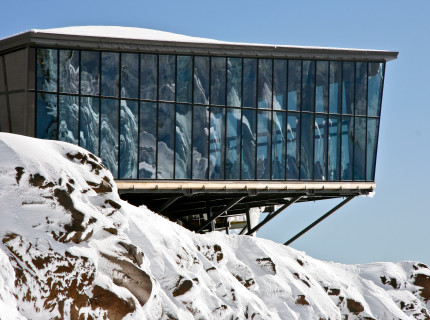Iron and Steelmaking Slag
The main by-product of steelmaking is slag (known as steel aggregate). Slag is non-metallic residue from the iron and steelmaking processes. It contains minerals such as silica, alumina and titanium from the ironsand and other combinations of calcium and magnesium oxides, derived from other raw materials. It is produced in four different processes of the steelmaking operation. In the iron melters, iron slag is formed by fusion of limestone, ash and other fluxes added to the original ironsand (silica, aluminium, titanium). Iron slag is less dense than the molten iron in the large melters and so floats on top of the iron. This allows the slag to be tapped (poured) from the melter separately.
Steel aggregate is produced in the vanadium recovery unit and the oxygen blowing furnace. In these processes steel slag rises to the surface of the ladle or furnace after oxygen has been blown into the hot metal, resulting in oxidisation. The slag is then poured or scraped off the molten metal. Steel slag may contain a small amount of steel and this is recovered when the slag is processed into the various saleable products. The majority of the slag from New Zealand Steel to be processed into a form where it can be reused for a range of applications. Of real significance is the fact that many of the applications for steel aggregate are enhancing our environment by reducing the need to quarry for alternative materials such as scoria and river gravel.
All steel aggregate products are rigorously tested before being released on the market to ensure that the steel aggregate will not adversely affect the environment in which it will be used and that it is suitable for the application.
Making Products from Steel Aggregate
The process of preparing slag products starts by cooling and solidifying the hot molten steel aggregate in excavated pits. Once it has cooled, steel aggregate is broken up and steel is recovered for recycling in the steelmaking process. The remaining slag material is left outside to weather. It is then further reduced in size by standard crushing and screening of particles, to produce aggregates that meet market needs. Since the mid 1980s a range of environmentally acceptable products have been developed for use in road surfacing, soil conditioning, road stabilisation and sportsfield drainage, as well as grit for sandblasting and filtering media for wastewater treatment. Iron slag is sold as drainage material (Ecoflow). This product has been used by the Auckland Council for construction of football fields. Ecoflow has also been used for bowling greens in Howick, an all weather hockey field at Pukekohe and for golf greens at Whitford Park, Pakuranga Country Club and Formosa. The Auckland Council uses an Ecoflow wetland as final treatment of sewage at Waiuku. The use of steel aggregate from the Glenbrook Mill site was recognised nationally with the presentation of the "Green Ribbon Award" from the Ministry of the Environment in 1994.
Ferrous Metal Recovery
About 100,000 tonnes of ferrous metal scrap is generated at the Glenbrook Steel Mill each year. When there is a delay in the steelmaking process, periodically hot iron or metal has to be tipped into large open beds, in readiness for reprocessing. Having to tip liquid metal is costly to the company in terms of energy, time and materials, so this is avoided whenever possible. Other ferrous metal scrap arises when strips are cut to size or process problems occur resulting in poor quality product.
Reuse of Chemicals
Before cold rolling of steel can occur, the scale layer formed during hot rolling must be removed. This takes place at the pickle line, which consists of hydrochloric acid baths into which the steel strip is immersed. Instead of using the mild hydrochloric acid only once, it is regenerated and returned to the pickling baths for reuse. A valuable product is also produced from the acid regeneration process. This is a red iron oxide which can be sold by New Zealand Steel for a variety of uses from pigment in paints to the production of magnetic media for tapes, videos and compact discs. Significant environmental and cost savings are made by recycling this acid and the need to dispose of a large quantity of waste acid is avoided.
Commitment to Recycling
All employees are encouraged to recycle and reuse unwanted materials or by-products arising from their work at the transfer station on site. The bins are emptied and any recyclable materials recovered. Used oil, drums, pallets, ferrous and non-ferrous metals, paper, cardboard and many other items are collected by various recycling agents. Recovering, reusing and recycling can provide cost savings and benefits for the company.
Tough Targets to Eliminate Waste
A major source of waste going to the landfill in the past was the intermediate product from the kilns called RPCC. RPCC is produced when the raw materials ironsand and coal are mixed together and heated in the multi-hearth furnaces and rotary kilns - the beginning of the ironmaking process. When the process is working well and the RPCC product meets quality standards, it is fed into the two large electric melting furnaces to make iron. If breakdowns or delays occur, then the RPCC must be held until the problems are resolved. A large storage hopper will hold 750 tonnes of hot prime RPCC and this can then be transferred when the process is up and running again. Until mid 2019, if RPCC was not up to specification, or the storage hopper became full, it was land-filled. From 2017 to 2019 investigation into the means of diverting RPCC from land-fill were progressed. Now, with careful management RPCC can be recovered to the Iron Plant, thus avoiding land-filling.
Landfill
Some by-products cannot be reused or recycled at this time, so must be disposed of in a landfill. New Zealand Steel operates a landfill for unwanted materials that are not hazardous. (Hazardous materials are taken off-site for treatment by a specialist Auckland company). About 155,000 tonnes of waste is deposited into the steel mill's landfill each year. There are many controls on the construction and operation of the landfill to ensure that any adverse effects to the environment are minimised. The landfill was constructed in an area where there was a natural valley and an almost impermeable clay layer. In preparing the landfill the topsoil was removed and put aside for use during the rehabilitation of the landfill site. Then the natural clay layer was compacted, ensuring that there was a good thickness throughout the area which would be land-filled.
Drain pipes and drainage material (our own steel aggregate) are laid on the base of the landfill. Water, or leachate, will seep from a landfill as a result of rain falling on the area or as the water drains from any wet materials. Leachate may contain contaminants which could be harmful to the environment if released untreated. The compacted clay layer and drainage material at the bottom of the landfill are important in the capture of landfill leachate which will pass through treatment ponds. Once a section of landfill is filled with waste it is rehabilitated. This involves putting a compacted clay layer over the waste and placing topsoil over the clay. The area is sown with grass seed. The rehabilitated landfill can then be safely used to graze livestock.



